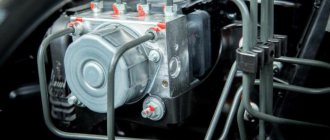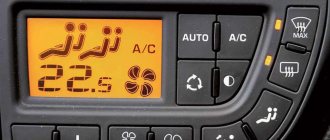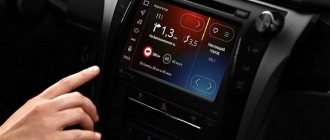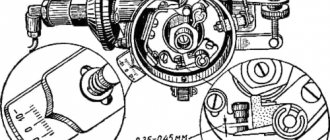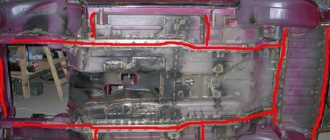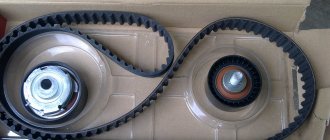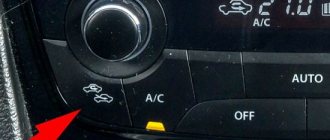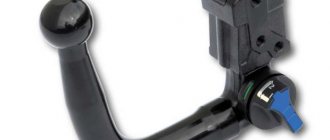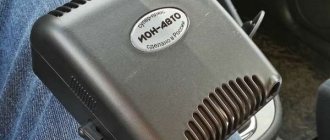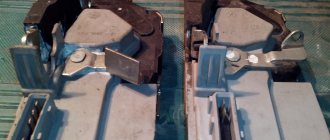Maximum traction is achieved by a wheel that keeps its tread contact patch at rest relative to the road surface. Both braking and acceleration of the car can cause slippage in this friction pair. The physical phenomena here are the same, the only difference is in the sign of the acceleration, it will be negative in the first case and positive in the second. But this does not affect the essence of what is happening, since both cases do not bring anything good.
Why is ASR needed?
The abbreviation ASR is of German origin and is an abbreviation of the long German word “Antriebsschlupfregelung”, which literally means “slip control”. It refers to an electro-hydraulic system designed to prevent the wheels from losing traction with the road surface. ASR in its modern form was first used in 1979 on some BMW car models, and its very first version was tested in 1971 on American Buick cars. Now this traction control system is used by all the world's leading automobile manufacturers, who call it differently, for example, in Toyota cars its analogue is called TRC, in Opel - DSA, in Range Rover - ETC, in Honda - TSC, in Volvo - STC.
In fact, ARS is an “advanced” version of the ABS system: it not only fully performs all its functions, but also does not allow the car’s drive wheels to slip during intense acceleration and starting. Thus, when braking, ASR functions as an anti-lock braking system (ABS), and while driving it acts as a traction control system.
SRS errors
As mentioned above, the SRS system is quite complex in its design, and therefore various errors may periodically occur in its operation. As practice shows, they are most often caused by such reasons as:
- Faulty wiring or contacts;
- Problems with the electronics of control modules;
- Terminals disconnected and fuses blown.
Whatever the cause of the SRS error, it is strongly recommended not to try to fix it yourself. It is best to go to a service station when it occurs. Its specialists will conduct a thorough diagnosis of the system and fix the problem.
How does ASR work?
ASR OFF button to turn off the ASR system
The ASR system prevents wheel slip in three ways:
- By slowing them down;
- Reducing the torque of the power unit;
- A combination of the first two methods.
If the car is moving at a speed not exceeding 80 km/h, then ASR, when it detects that any of the wheels is spinning faster than the others, brakes it using the braking system. If the speed exceeds this limit, then the rotation speed of the too “fast” wheel is reduced by reducing the torque of the power unit transmitted to it. A combination of these methods is considered the most effective and is used when the car is moving at a sufficiently high speed.
The operation of ASR is controlled by a special electronic unit. It receives signals from many sensors that monitor the most important parameters of the vehicle. This information is processed by the software embedded in the block, resulting in the generation of control signals transmitted in real time to actuators.
The ASR traction control system changes the braking force according to a specific cycle. As soon as its control unit receives information from the sensor about excessive wheel speed, a signal is generated to increase the pressure in the corresponding circuit of the brake system. It follows the actuator, which is triggered. The slipping wheel is braked, and an element of the executive part of the system, such as a return pump, maintains increased pressure until the wheel speed is completely normalized. As soon as this happens, a signal from the sensor enters the control device, and it issues a pressure release command, which is immediately executed.
Counteracting wheel slip by regulating the torque of the internal combustion engine is carried out using the internal combustion engine control system. At certain speeds, when wheel slip occurs, this is detected by the ASR control unit and a corresponding signal is sent to the engine control unit. The latter, in accordance with it, brings the torque to the required values. This is done in the following ways:
- Changing the throttle position;
- Adjusting fuel injection parameters;
- Regulating the pulses of the ignition system.
In some versions of ASR systems, torque control is also achieved by varying the gears. This method is used on cars equipped with automatic transmissions.
Deciphering abbreviations
What does the brand owner want to say by indicating that his cars are equipped with an ASR system? If you decipher this abbreviation, you get Automatic Slip Regulation, and in translation - automatic traction control system. And this is one of the most common design solutions, without which modern cars cannot be built at all.
However, every manufacturer wants to show that their car is the coolest and most special, so they come up with their own abbreviation for their traction control system.
- BMW is ASC or DTS, and the Bavarian automakers have two different systems.
- Toyota – A-TRAC and TRC.
- Chevrolet & Opel – DSA.
- Mercedes - ETS.
- Volvo-STS.
- Range Rover - ETC.
It hardly makes sense to continue the list of designations for something that has the same operating algorithm, but differs only in details - that is, in the method of its implementation. Therefore, let's try to understand what the principle of operation of the system that prevents wheel slip is based on.
How does ASR work?
As mentioned above, ASR is a variant of ABS with enhanced functionality. Therefore, in addition to the sensors, modulators and control unit, which are the main components of the anti-lock braking system, it also includes:
- Return pump;
- Solenoid valves;
- Signal generation module for engine control unit.
The return pump is used to create additional pressure in the brake system, and when it is turned on, it begins to function as the brake master cylinder. Solenoid valves are responsible for connecting this pump and, when the moment comes, releasing the excess pressure. As for the signal generation module for the engine control unit, its purpose is quite clear from the name itself. It is used in cases where ASR operates in the power unit torque reduction mode.
The design of modern traction control systems provides a function of informing about their operation: at this moment, a special light comes on in the car interior, on the dashboard. It should be noted that drivers have the opportunity to disable the ASR installed in their vehicles, however, experts do not recommend doing so, since this traction control system does provide increased safety and its use in cars has a number of important advantages.
Pros and cons of a car's traction control system
By preventing the drive wheels from slipping, the system gives the car, especially with a very powerful engine, several useful features:
- confident start from a standstill in the most efficient mode, when the wheels are constantly supported on the verge of failure;
- rapid acceleration, limited only by the coefficient of road adhesion, and not by the driver’s abilities;
- reduced tire wear on the drive wheels;
- increased safety when cornering under traction on a slippery road, the system prevents the car from turning into an uncontrolled skid;
- fuel is saved, which is not spent on the useless burning of tire rubber when slipping on dry asphalt;
- increased cross-country ability when the rotating wheel is not allowed to dig a hole under itself, where it remains until the tractor arrives, while the second wheel will receive additional torque, which will allow it to successfully pull out of a mud ambush.
There are also disadvantages that developers struggle with, not always successfully:
- wear of brake pads and discs increases;
- the car’s differential is overloaded, which is not always designed to transmit significant power to only one wheel;
- difficulties of compromise when choosing the threshold for the system to operate, beyond which it actively intervenes in control;
- difficulties in selective shutdown if the machine has a large set of additional functions for autonomous control of brakes and traction.
Recently, ASR is almost not used independently, but works with other electronic assistants, for example with the ESP stabilization system.
Principle of operation
The ESP system is an active vehicle safety system that automatically turns on when the vehicle skids or loses control. The system computer receives data from several sensors (lateral acceleration, wheel rotation, steering wheel position, gas and brake pedal positions, brake system condition and angular speed).
The operation of the ESP is based on activating braking and reducing engine torque in order to prevent the car from skidding.
What commands can be issued in a given situation on the road:
- Braking one or all wheels. This will help prevent skidding or help increase the turning radius at high speeds. Also, ESP in a certain situation can reduce the braking force, even if the frightened blonde presses all the pedals with all her might.
- Connection to the engine control unit in order to turn off its cylinders in order to reduce its speed (torque), up to completely turning off the gas pedal.
- Adjusting the rotation of the front wheels.
- In cars with adaptive suspension, it affects the performance of the shock absorbers, and they affect the damping of the springs (the degree of shock absorption).
- Adjusting the automatic transmission to change gears.
- If a driving problem occurs as a result of operating cruise control, it will act together with ESP and other systems to smooth out the vehicle's movement.
Despite the fact that this is a very advanced safety system, it cannot see the actual width of the roadway, nor can it accurately calculate the trajectory of the car that will be the safest. It follows that the driver himself must direct the car in the desired direction, and ESP will provide stability and controllability.
The anti-skid system can operate at any speed and vehicle operating mode (coasting, braking, acceleration).
When cornering, ESP monitors the trajectory of movement, which should be the position of the steering wheel. If deviations appear, the stabilization system will reduce engine speed and slow down in order to quickly return the vehicle to its previous trajectory. ESP is especially useful on icy or wet roads.
Video: ESP. What it can do and how it works
For example, at a very high speed when turning a car began to skid. If the driver starts to brake, the car may spin out. If he does not press the brake, there is a chance of flying off the road into a ditch. The active anti-skid system will instantly determine which wheels need to be slowed down or by how much the fuel supply needs to be reduced in order to straighten the trajectory. Agree, this is a mega-useful thing in critical situations. You just turn the steering wheel, and the stabilization system itself thinks about how best to fit even into a sharp turn.
What else is useful in the ESP system?
- Differential locking function, which allows you to transfer torque to exactly that wheel in order to level the car. The differential must have electronic filling. This is a device that transmits different torques to each consumer.
- Help the driver keep the steering wheel in the desired position. This is especially useful in a rut.
- Rear wheel steering. The main thing is that this function is already installed on the car.
Let's look at the operation of ESP using real examples.
What does ESP consist of?
The system includes a control unit, measuring instruments that monitor various parameters, and a hydraulic unit.
ABS anti-lock braking system
.
— Anti-slip system ASR.
— EBD brake force distribution system
.
— Electronic differential locking system
EDS
.
What is ESP in a car?
Electronic
Stability Program ,
or
ESP
, is an electronic stability control system, also called stability control. The main purpose of ESP is to control the torque of the wheels, which allows you to eliminate lateral movement and level the position of the car.
Like ASR, the system has several analogs that are used in specific brands of cars:
- ESC
is installed on KIA, Hyundai and Honda cars . - Rover, BMW and Jaguar are equipped with DSC
. - A distinctive feature of Volvo is the DTSC
. - VSA
in Acura cars . - Toyota models are equipped with VSC
. - Subaru, Nissan and Infiniti cars use the VDC
.
What does this give?
During emergency braking, cars equipped with ABS slow down smoothly rather than skidding. Consequently, even in difficult road conditions the car remains controllable. The driver only needs to monitor the direction of movement of the car until it comes to a complete stop. In other words, the anti-lock braking system provides controlled braking, which helps avoid an accident.
When emergency braking a vehicle not equipped with ABS, pressing the brake pedal hard means that no matter how much you twist the steering wheel, the car will not change its trajectory. This is because locked wheels will slip and prevent the driver from maneuvering. As a result, the car will drive in a straight line, which can lead to serious consequences.
